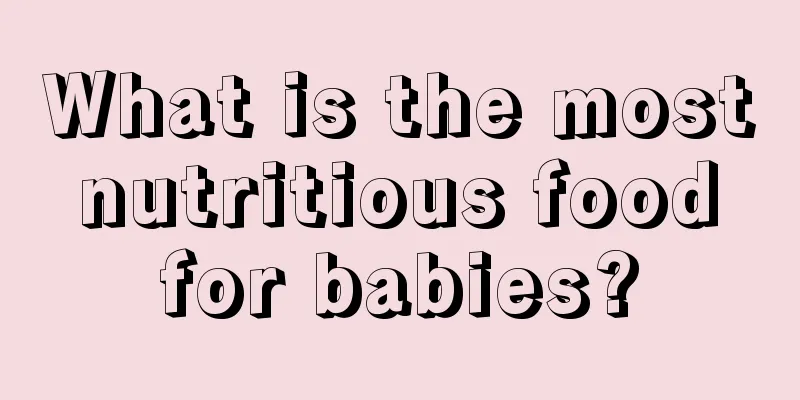What is the most nutritious food for babies?

|
Most parents are very concerned about their baby's diet and hope to give their children the best so that they can grow up healthier. Nutrition is the most important factor in helping babies grow, so what is the most nutritious thing for babies to eat? There are many nutritious foods that babies can eat, such as vegetables, fruits and meat. However, since babies do not have many teeth and have poor chewing ability, meat is mostly eaten in soup, and babies cannot chew meat. Here are some nutritious foods for your baby. Spinach: Rich in various vitamins, it ranks first on the list. One cup of spinach contains more than 100% of the DRI for vitamin K and lutein. It also contains vitamin A, manganese, folate, magnesium, calcium and iron as well as flavonoids and carotenoids. How to eat: Spinach is more nutritious when eaten cooked. The way of eating is quite casual, it can be stir-fried or made into soup. Cabbage: Cabbage is extremely high in vitamin K. One cup of cooked kale contains more than 10 times the Dietary Reference Intake (DRI), a daily recommended amount of vitamin K, which helps platelets clot. How to eat: Add lemon, garlic and a small amount of water and cook together. Radish greens: Radish greens are rich in vitamin K and lutein. 2/3 cup of radish greens contains 100% of the DRI for vitamin K and lutein. Vitamin C reaches more than 75% of the DRI. How to eat: The simple way to eat is to wash it and dip it in sauce. It can also be eaten cold or stir-fried with shredded pork. Lettuce: Lettuce is rich in vitamin A, which can protect teeth and skin. 1.5 cups of cooked romaine lettuce (celery) contains 100% of the DRI for vitamin A. Vitamin A is important for maintaining healthy teeth and skin. How to eat: Cut the lettuce into thin strips, mix it with diced chicken, shape it into patties, and grill it. Pumpkin: Pumpkin is rich in carotene. Pumpkin peel is rich in carotene, vitamin C, vitamin K and cellulose. The carotene content of pumpkin heart is 5 times that of the pulp. How to eat: The pumpkin can be steamed and then mashed into pumpkin puree. It can be added with other vegetables or meat to make pumpkin pancakes, which can be sweet or savory. Mustard greens: Mustard greens are extremely high in lutein and vitamin K. It is also rich in vitamin A, B vitamins, vitamin C and vitamin D, carotene and dietary fiber. How to eat: Mustard greens are mainly used as a side dish, stir-fried or cooked into soup. But please note that mustard greens should not be eaten raw or in large quantities. Sweet potatoes with skin: high in potassium. One sweet potato with skin, about 13 cm long, contains 10% of the DRI for potassium. How to eat: Cut in half and bake in the oven for 30 minutes. Broccoli: Low in calories, high in fiber, and contains more vitamin C than cabbage, tomatoes, and celery. How to eat: Serve cold or add to salad. Carrot: Contains 1.35-17.25 mg of carotene per 100 grams. It also contains B vitamins, vitamin C, fats, sugars, iron, pectin, inorganic salts, etc. How to eat: Eating carrots raw can clean teeth, but roasting them whole is more nutritious. Red bell pepper: Rich in vitamin C. One red bell pepper contains 250% of the DRI of immune-boosting vitamin C. How to eat: Chop it and mix it with celery, then drizzle it with olive oil and vinegar. What is the most nutritious food for babies? The above article introduces a variety of foods that babies can eat, and they are all nutritious foods. Parents should pay attention to the method when adding complementary foods to their babies. Vegetables can be put into porridge or made into rice noodles and mixed together. When adding complementary foods, the intake of milk should also be increased. There is no contradiction between babies eating breast milk and complementary foods. Parents should add food according to the baby's living habits and food intake. |
<<: What should babies eat if they are zinc deficient?
>>: What are the symptoms of baby convulsions?
Recommend
How old can babies eat tofu?
Tofu is a very simple ingredient for us. It can b...
Is it necessary to supplement cod liver oil for newborns?
Cod liver oil is a substance extracted from fish ...
Why is the little boy's genitals swollen?
If parents find that a little boy's genitals ...
What causes abdominal distension and vomiting in children?
Friends who have babies at home are worried about...
Why does my child’s hair become oily?
The problem of oily hair is most likely to occur ...
The causes of mycoplasma infection in children must be known by mothers
Mycoplasma infection in children is a common resp...
Why does the baby dance and not sleep?
Babies' ability to express themselves is rela...
What should you pay attention to when changing diapers for newborns?
We all know that for newborn babies, since their ...
What is the reason for the black spots under the child's eyes? Is it caused by sleep?
Eyes are the windows to the soul. You can imagine...
The child has a low-grade fever of more than 37 degrees
Although a person's normal body temperature i...
How to feed newborns scientifically
Reasonable feeding methods can help newborns deve...
6-year-old teeth have not fallen out and new teeth have grown
During childhood, we need to replace our teeth. T...
Six-year-old child has pain around belly button
As children grow up, parents all hope that they c...
What should I do if my child has ringworm on his face?
The problem of ringworm on children's faces w...
What causes children to have nightmares?
Both adults and children can have nightmares. In ...









